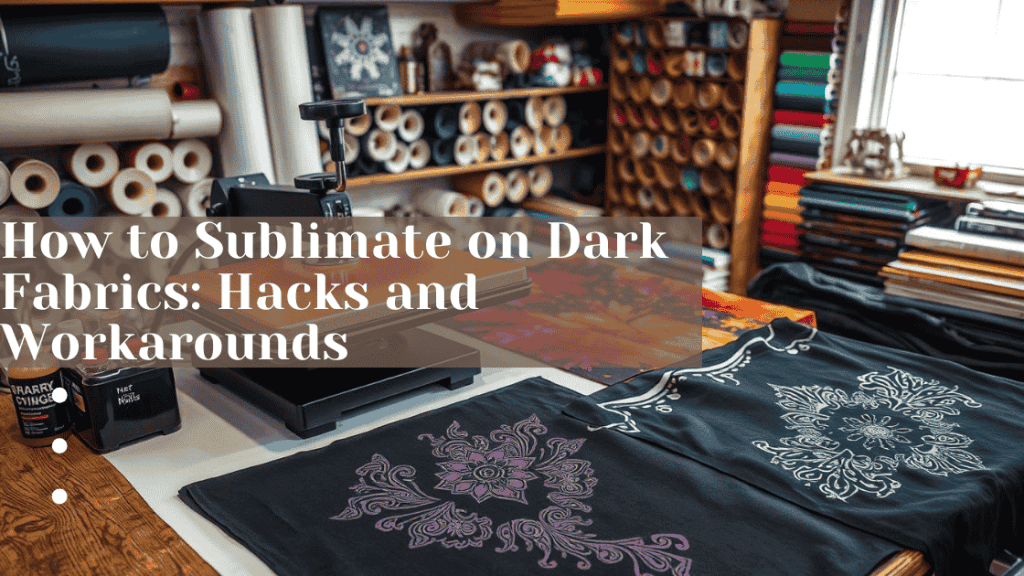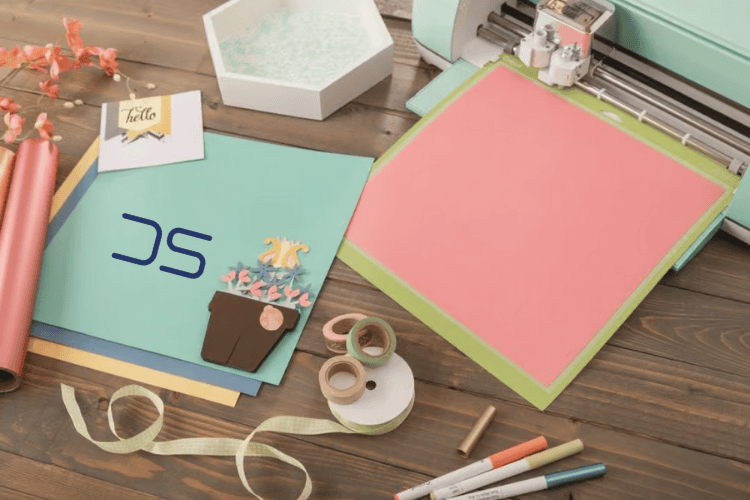How to Sublimate on Dark Fabrics: Hacks and Workarounds
Sublimation printing is a favorite for customizing fabrics. But, it’s tough on dark fabrics. The heat transfers dye, but dark colors can hide it. So, we need special tricks and stuff to make it work.
Sublimation and heat transfer are key for bright designs on dark fabrics. They help us get the look we want.
Key Takeaways
- Sublimation printing is a popular method for customizing fabrics, but it has limitations when it comes to dark fabrics.
- Dark colors can prevent the dye from showing up clearly, requiring special techniques and materials.
- Heat transfer is essential for creating vibrant designs on dark fabrics.
- Traditional sublimation methods may not work on dark fabrics, requiring alternative approaches.
- Sublimation printing on dark fabrics requires a good understanding of the materials and techniques involved.
- With the right techniques and materials, it’s possible to achieve professional-looking results with sublimation printing on dark fabrics.
Understanding the Challenge of Sublimating Dark Fabrics
The sublimation process changes a solid into a gas without going through liquid. This is tricky with dark fabrics because of their color and material. The science shows that dye transfer depends on the fabric’s type and color.
Dark fabrics soak up dye, making it hard to get vibrant colors. The color theory explains that dark colors absorb more light. This makes it tough for dye to show up well, leading to faded or distorted prints.
- Fabric type: The fabric’s absorbency affects dye transfer. Different fabrics absorb dye differently.
- Color intensity: Darker colors are harder to sublimate than lighter ones.
- Dye quality: Better dyes produce brighter colors. Poor dyes can result in faded prints.
Knowing these challenges helps find ways to get good results. You might use special dyes, adjust the sublimation process, or try heat transfer vinyl. Understanding fabric limitations and color theory helps achieve quality prints on dark fabrics.
Essential Materials and Equipment
To start sublimating on dark fabrics, you’ll need the right stuff. This includes sublimation ink made for dark fabrics, a heat press that gets very hot, and the dark fabric itself. These basics are key for vibrant and lasting results.
Here’s a list of essential items to get you started:
- Sublimation ink
- Heat press
- Dark fabric (such as cotton, polyester, or a blend)
- Vinyl
When picking a heat press, think about size and temperature range. A bigger press is great for large projects, while a smaller one is better for small designs. Vinyl is also crucial, as it makes the surface smooth for the ink to stick to.
Understanding the role of sublimation ink and vinyl is key. With these and a good heat press, you’re set to make amazing designs on dark fabrics.
| Material | Description |
|---|---|
| Sublimation Ink | Specifically designed for dark fabrics |
| Heat Press | Capable of reaching high temperatures |
| Vinyl | Creates a smooth surface for sublimation ink |
Preparing Your Dark Fabrics for Sublimation
Getting dark fabrics ready for sublimation takes some steps to get the best look. It’s important to prepare the fabric well for vibrant and lasting prints. A key part of this is pre-treatment, which can mean applying a special solution to help the dye stick better.
Here are some common pre-treatment methods:
- Coating the fabric with a sublimation-specific solution
- Using a fabric primer to enhance dye adherence
- Applying a surface modification treatment to improve print quality
Along with pre-treatment, using surface modification can also boost print quality. This might mean adding a special coating or treatment to the fabric. It helps the dye bond better. By following these steps and using the right techniques, you can get professional-looking results with your dark fabric sublimation projects.
How to Sublimate on Dark Fabrics: Hacks and Workarounds
Sublimating on dark fabrics can be tough, but with the right sublimation hacks and dark fabric solutions, you can get great results. One good trick is to use a white base layer or a special coating. This helps the sublimation ink stick to dark fabrics and show up well.
For DIY methods, try using a heat press at 350-400°F (175-200°C) and 40-50 psi pressure. Also, test different fabrics like polyester or cotton-poly blends to see what works best.
- Use a high-quality sublimation ink made for dark fabrics
- Pre-treat the fabric with a fixative or coating to improve ink adhesion
- Try mirror printing or reverse printing for cool effects
With these sublimation hacks and dark fabric solutions, you can explore more creative ideas. Whether you’re a pro or a DIY fan, these tips will help you get amazing sublimation prints on dark fabrics. They’ll take your projects to the next level.
Using Heat Transfer Vinyl as a Base Layer
Using heat transfer vinyl as a base layer is a great way to sublimate on dark fabrics. It makes prints vibrant and durable, even on hard-to-sublimate fabrics. The trick is to pick the right vinyl and apply it correctly.
The process starts with selecting the right vinyl type. There are many types of heat transfer vinyl, each suited for different fabrics. You can choose from matte, glossy, and metallic finishes.
Selecting the Right Vinyl Type
When picking a vinyl, think about the fabric’s color and texture, and the finish you want. For example, matte vinyl works well on cotton or polyester blends. Glossy vinyl is better for nylon or spandex.
Application Techniques
To apply the vinyl, follow these steps:
- Preheat the fabric to the recommended temperature
- Cut the vinyl to the desired shape and size
- Apply the vinyl to the fabric using a heat press or iron
- Allow the vinyl to cool and set before handling
Using heat transfer vinyl as a base layer can make your sublimation prints look professional. It’s especially useful for dark fabrics where regular sublimation doesn’t work well. With the right application, you can explore new creative possibilities in your sublimation projects.
Troubleshooting Common Issues
Issues like bubbling, peeling, or uneven adhesion can happen. To fix these, check your temperature and pressure settings. Make sure the fabric is prepared well. Use a high-quality heat transfer vinyl made for sublimation.
| Vinyl Type | Fabric Compatibility | Finish |
|---|---|---|
| Mattte | Cotton, Polyester | Mattte |
| Glossy | Nylon, Spandex | Glossy |
| Metallic | Blends | Metallic |
The White Base Method
The white base method is a technique for sublimation on dark fabrics. It involves applying a base coating before sublimation. This method makes the sublimation ink on dark fabrics more visible and vibrant.
Some benefits of the white base method include:
- Improved color visibility and vibrancy
- Enhanced durability of the sublimation ink
- Reduced risk of ink bleeding or fading
To apply the white base coat well, follow the manufacturer’s instructions. Use the materials they recommend. This method works with different dark fabrics like cotton, polyester, and blends.
Using the white base method can lead to professional-looking results. It’s great for custom designs or prints on dark-colored fabrics. This includes t-shirts, hoodies, or tote bags.
| Method | Benefits | Drawbacks |
|---|---|---|
| White Base Method | Improved color visibility, enhanced durability | Additional cost, potential for uneven coating |
Advanced Techniques for Professional Results
To get professional-looking results in sublimation on dark fabrics, you need to learn advanced techniques. One key method is multi-layer sublimation. This involves adding multiple layers of sublimation ink for deeper, brighter colors. It’s important to manage colors well to avoid dull or distorted prints.
Color management is crucial in sublimation. It can greatly affect the final look. Using special software to design and adjust colors ensures your prints look amazing on dark fabrics. Important color management steps include:
- Choosing the right color profile for your sublimation printer and ink
- Adjusting the color curve to optimize brightness and contrast
- Using color correction tools to compensate for any color shifts or distortions
By using advanced sublimation techniques and careful color management, you can achieve stunning results. These methods are perfect for creating custom apparel, accessories, or home decor. They help you make vibrant, lasting prints on dark fabrics.
With practice and patience, you can master these advanced techniques. Always follow care instructions and use quality materials. This ensures your sublimation prints last a long time.
| Technique | Description |
|---|---|
| Multi-layer sublimation | A technique that involves applying multiple layers of sublimation ink to achieve a deeper, more vibrant color |
| Color management | The process of adjusting and optimizing the color palette to ensure that the colors blend harmoniously and look their best on dark fabrics |
Maintaining Quality and Durability
To keep your sublimation prints on dark fabrics looking great, follow some key care steps. Wash them in cold water and avoid using bleach or harsh chemicals. Also, dry them on a low heat setting. This helps keep the print’s colors bright and the fabric in good shape.
Keeping your prints looking good is important. Use top-notch sublimation ink and follow the maker’s care tips. Applying a fixative or clear coat can also protect the print from fading or smudging.
Proper Care Instructions
- Wash in cold water
- Avoid bleach or harsh chemicals
- Dry on a low heat setting
- Avoid ironing or steaming the print
By following these care tips and using quality materials, you can make your sublimation prints last longer. Proper care ensures your prints stay vibrant and in top condition.
Extending Print Life
Follow these tips and use quality materials to make your prints last longer. Always follow the maker’s care and application instructions for the best results.
Conclusion
Sublimating on dark fabrics has its own set of challenges. But, with the right tools and techniques, the sky’s the limit. You can use heat transfer vinyl as a base or try the white base method. These hacks can help you get bright, lasting designs on dark materials.
Sublimation on dark fabrics is all about trying new things. Try out different methods and adjust your settings. Don’t be afraid to think outside the box. With time and effort, you’ll turn plain dark fabrics into amazing pieces.
So, what are you waiting for? Start sublimating on dark fabrics today. You can create custom clothes, accessories, and home decor. Let your creativity shine and make your world a more colorful place!
FAQ
What are the main challenges of sublimating on dark fabrics?
Sublimating on dark fabrics can be tricky. The dark color often blocks the dye transfer. This makes it hard for the sublimation ink to show up well.
What equipment and materials are needed for sublimating on dark fabrics?
To sublimate on dark fabrics, you need special sublimation ink. You also need a heat press that can get very hot. And, of course, you need the dark fabric itself. Making sure the fabric is ready is also key.
How can I prepare dark fabrics for the sublimation process?
Preparing dark fabrics for sublimation involves a few steps. You can use pre-treatments, prepare the surface, and adjust the heat and pressure. These steps can really help your results.
What are some hacks and workarounds for sublimating on dark fabrics?
For sublimating on dark fabrics, some hacks work well. You can use a white base layer, apply special coatings, or try heat transfer vinyl as a base.
How can I achieve professional-looking results when sublimating on dark fabrics?
To get professional results, try advanced techniques. Use multi-layer sublimation, manage colors carefully, and design with special software. These steps can make your prints look top-notch.
How can I maintain the quality and durability of my sublimation prints on dark fabrics?
To keep your sublimation prints looking great, follow care instructions. Wash and dry them as recommended. This will help your prints stay vibrant and last longer.



